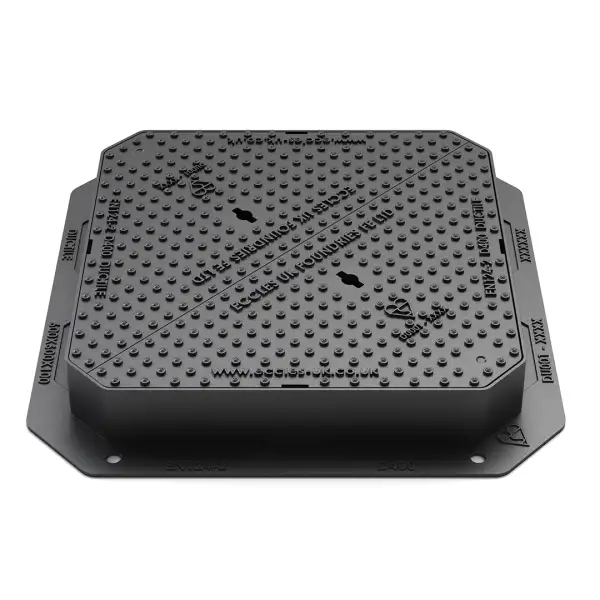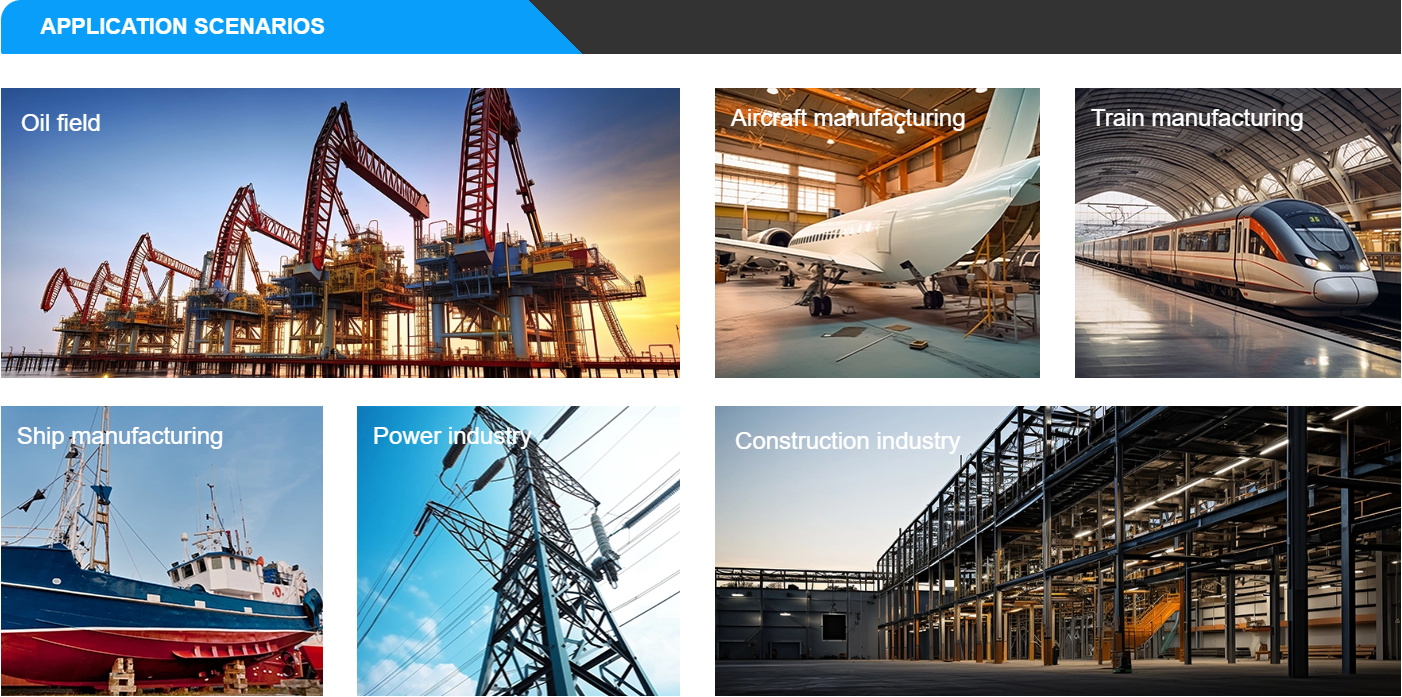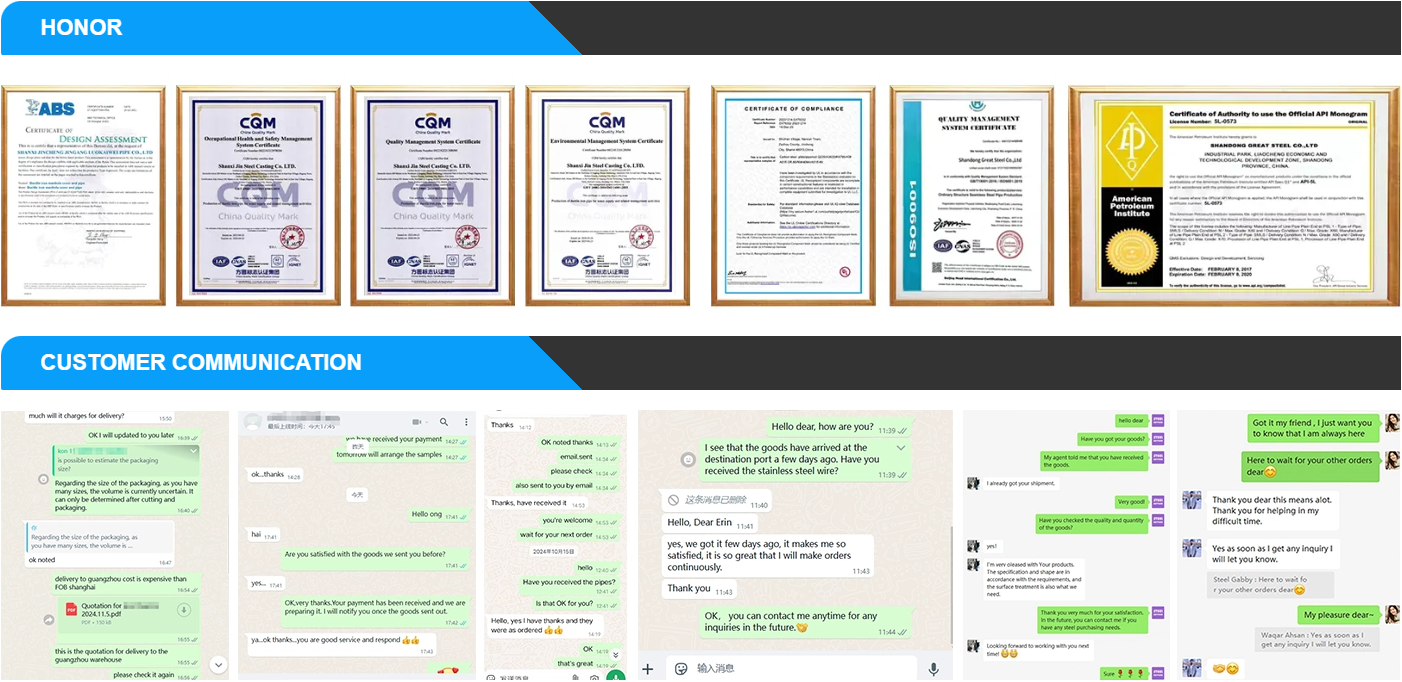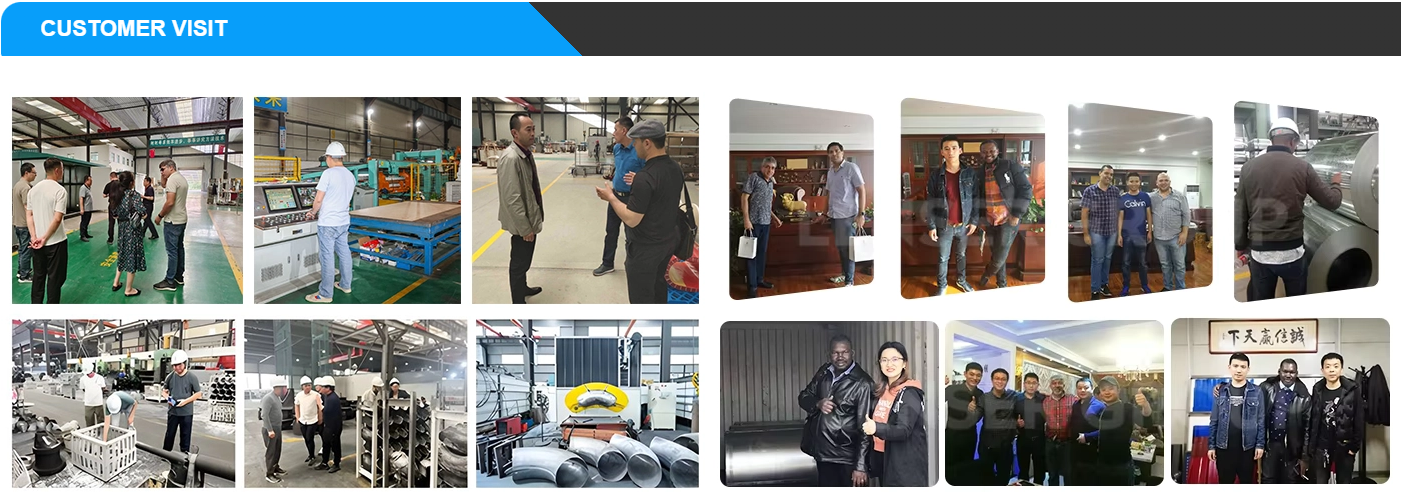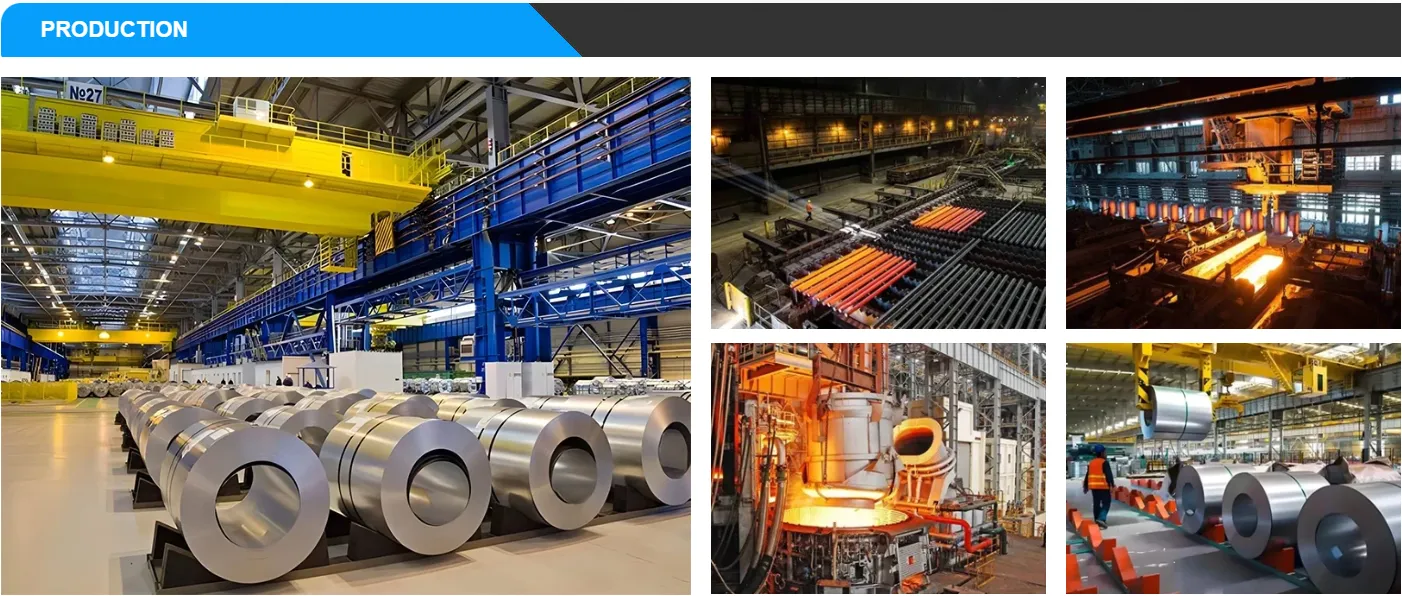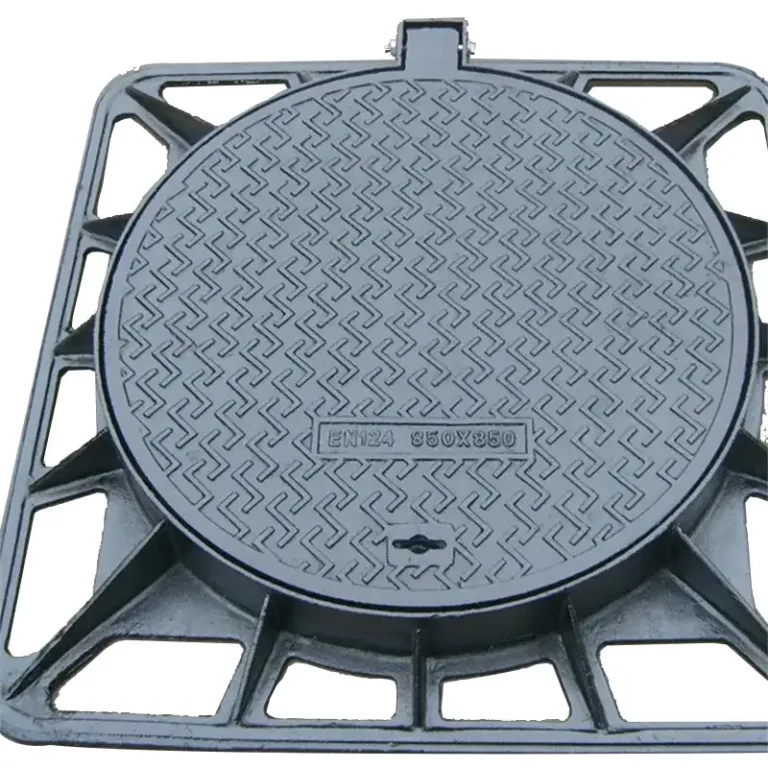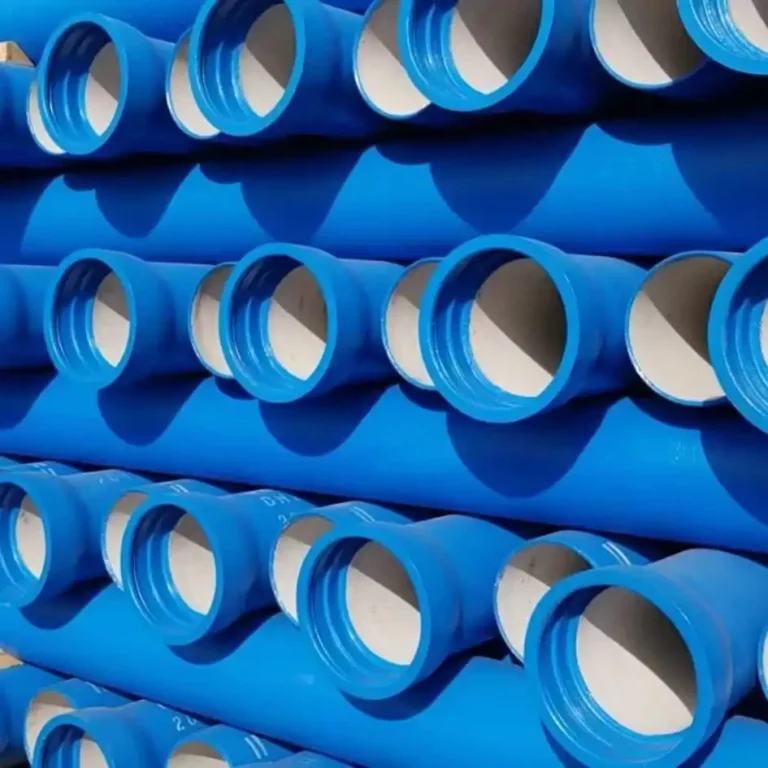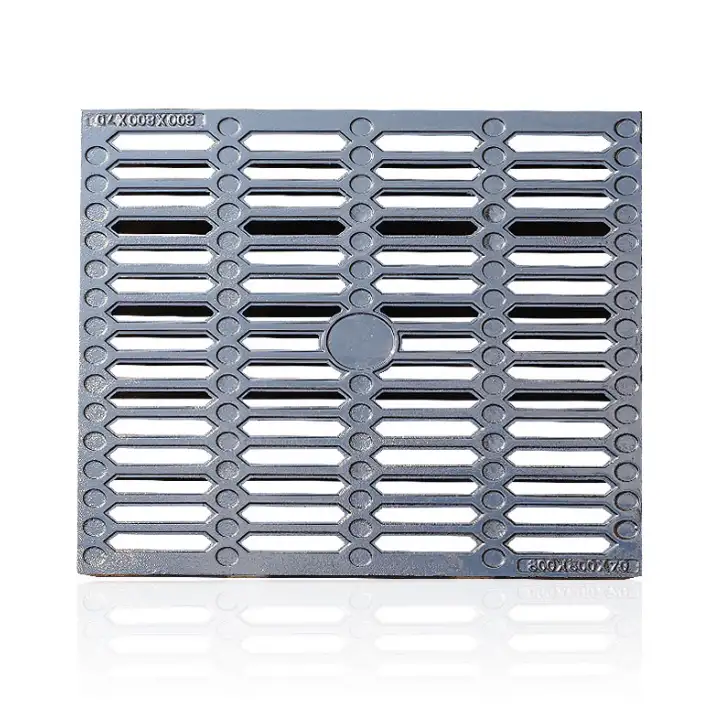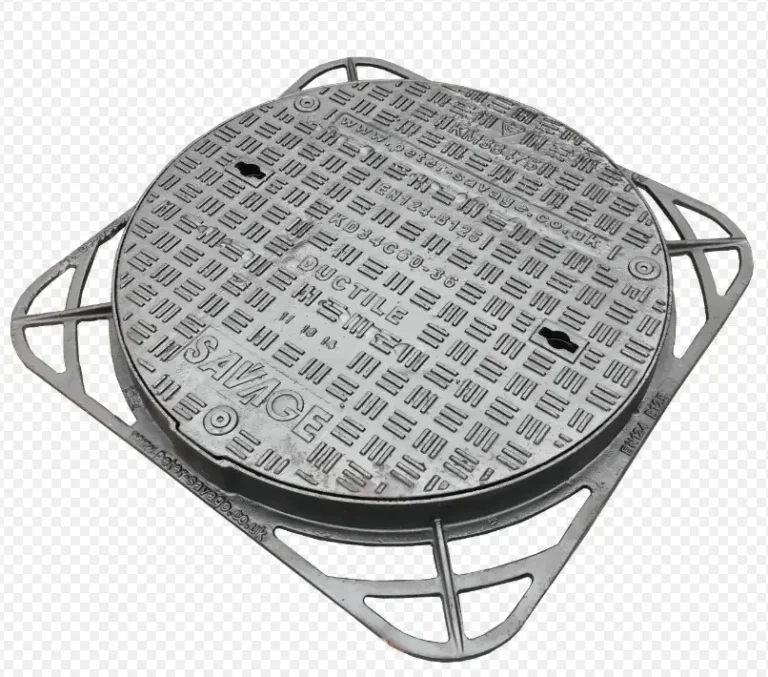Ductile iron access covers (also known as ductile iron manhole covers) are heavy-duty enclosures used to cover underground service openings in roads, sidewalks, industrial sites, and utility chambers. Made of spheroidal graphite (nodular) cast iron, these covers combine the high strength of steel with the corrosion resistance of cast iron. They meet strict international standards and are available in many shapes (round, square, rectangular) and load classes.
Material Properties of Ductile Iron
Ductile iron (spheroidal graphite iron) is an alloy of cast iron engineered to improve strength and toughness. Unlike gray cast iron where carbon forms flaky graphite, in ductile iron the graphite appears as spherical nodules. This metallurgical difference dramatically enhances mechanical properties. Typical ductile iron grades (per ASTM A536) have tensile strengths above 420 MPa and yield strengths above 300 MPa, on par with or exceeding mild steel. For example, one foundry notes “the tensile strength of ductile iron is more than 420 MPa and the yield strength is more than 300 MPa, which is the same as low-carbon steel and three times more than grey iron”. Ductile iron also retains significant ductility (elongation >7%) and toughness; its impact resistance is similar to that of carbon steel and roughly ten times that of gray iron. In short, ductile iron covers are high-strength yet not brittle.
This strength advantage allows ductile covers to be thinner and lighter than equivalent gray-iron covers, while bearing greater loads. One supplier notes that ductile covers of the same dimensions weigh about 30% less than gray-iron covers due to the higher allowable stress. The high-strength, high-toughness combination also means ductile covers deform slightly rather than fracture under extreme loads, reducing the risk of sudden failure. Ductile iron’s microstructure (spherical graphite) contributes to these properties.
Corrosion resistance is another important property. Uncoated ductile iron is vulnerable to rust like any cast iron, but typical practice is to apply bituminous or epoxy coatings to protect surfaces. Even with minimal rust protection, ductile iron performed better than ordinary steel in one salt-spray test (only 0.25× the corrosion of steel, 0.1× that of gray iron), suggesting inherently greater oxidation resistance. In most municipal applications (water, sewage, etc.), ducts report that cast iron resists corrosion and oxidation better than steel, and the nodular structure further improves performance. With proper linings (cement-mortar inside pipes) and coatings (epoxy, bitumen outside pipes and covers), ductile iron infrastructure routinely lasts decades.
In summary, ductile iron offers very high strength, good ductility/toughness, and long fatigue life, making it ideal for heavy-duty access covers. Its mechanical performance can rival steel: for example, an ASTM A536 Grade 65-45-12 ductile iron has yield and tensile strengths “very close to that of mild steel”. Designers often choose ductile iron because it provides the durability of steel with the economic advantages of cast products. (For reference, common ductile-iron grades include ASTM A536 60-40-18, 65-45-12, 80-55-06, and fully pearlitic grades like 100-70-03.)
Table 1: Comparison of Material Properties (typical values for a 600×600mm cover)
| Property | Ductile Iron | Gray Cast Iron | Carbon Steel | Composite/Polymer |
|---|---|---|---|---|
| Tensile Strength (MPa) | >420 (up to ~550) | ~200–300 (typ. 200) | 400–550 | 30–100 |
| Yield Strength (MPa) | >300 (up to ~380) | ~100 (approx.) | 250–350 | 5–50 |
| Elongation at Break | >7% (often 8–18%) | ~0% (brittle) | ~15–25% | Low |
| Impact Toughness (Charpy) | High (similar to steel) | Low (≈1/10 of ductile) | Medium-High | Low |
| Corrosion Resistance | Good (with coatings) | Poor (rusts quickly) | Moderate (needs coating) | Excellent (inert) |
| Density (kg/m³) | ~7500 | ~7200 | ~7850 | ~2000 (depending) |
| Weight (600×600 cover) | ~30–40 kg (cover+frame) | ~45–55 kg (heavier) | ~25–35 kg (frame weld) | ~5–15 kg (lightweight) |
| Cost ($ per cover) | Moderate (Economical vs steel) | Lower but brittle | Higher machining cost | Variable (higher B125) |
| Typical Use | Heavy-duty/manhole covers | Older drains, landscaping | Specialty or mod covers | Light-duty areas (parks) |
Sources: Material data from Dandong Foundry and Penticton Foundry; field experience.
As shown, ductile iron provides a superior balance of strength and durability. In practical terms, a 700×900mm D400-class ductile cover may weigh ~55 kg, whereas a comparable gray-iron cover would weigh more. Ductile covers can have anti-slip coatings, locking lugs, and other features without compromising structural integrity. Their high toughness also means covers can safely be made thinner, saving weight and cost relative to brittle castings.
Manufacturing Process
Ductile iron access covers are typically produced by casting followed by machining. The typical process for ductile iron covers includes sand casting with nodularizing treatment, heat treatment, machining, and surface finishing. Modern foundries often employ automated patterns and molding lines.
The raw material is molten cast iron, melted in electric induction furnaces. A magnesium alloy (often a magnesium-ferrosilicon nodulizer) is added to transform the carbon structure into spherical graphite nodules, creating ductile iron. Pipes may use centrifugal casting, but covers are usually produced by conventional sand casting (often using resin-bonded sand molds). Luokaiwei, for example, casts covers in sand molds (sometimes with cores for hollows), then subjects them to heat treatment (austempering) to achieve the desired ductile microstructure. This austempered process yields the high strength and ductility of the finished iron.
After casting, all covers undergo CNC machining of bearing surfaces and flanges. As noted by Luokaiwei’s technical data, “the manhole covers and frames… are cast to standard sizes… and rated for typical load classes”. Once cast and heat-treated, covers are trimmed and surface-finished (removing flash, shot blasting, etc.) to precise dimensions. Patterns are made to tight tolerances: Crescent Foundry boasts over 5,000 existing patterns, enabling quick development of new cover designs.
Finally, covers are coated or painted. A common finish is bituminous asphalt paint, which provides a nonslip black surface and corrosion protection. Some covers are painted grey or blue depending on utility (e.g. grey for roads, blue for water). Luokaiwei also offers epoxy coatings per AWWA C210 or other specifications for buried or chemical environments. Covers can be made with anti-skid patterns cast into the face, and locking features (bolts, hinges, seals) are added during final assembly.
Table 2: Ductile Iron Cover Manufacturing Features
| Step | Description | Notes/Standards |
|---|---|---|
| Melting | Raw iron melted in induction furnaces | Achieves uniform alloy before nodulizing |
| Nodularizing | Magnesium inoculation creates spherical graphite | Produces ductile microstructure |
| Casting | Sand mold or shell mold casting of cover frames & lids | Often resin sand molds; sizes e.g. 600×600 |
| Heat Treatment | Austempering (patenting) to set graphite structure | Enhances strength and toughness |
| Machining | CNC or manual machining of seating surfaces, hinges, flanges | Ensures precise fit and alignment |
| Coating/Finishing | Bituminous paint, epoxy, or powder coating | Anti-slip finish; corrosion protection |
| Assembly | Attach bolts, gaskets, lifting keys, caps, accessories | Includes optional locks, handles, leaf-hinges |
Overall, the manufacturing ensures covers meet EN124 tolerances: flatness of bearing surfaces, gap clearances, and load-bearing requirements. Manufacturers often certify their foundries to ISO 9001 quality systems and produce test samples. For example, Hebei Deko (made-in-China listing) highlights ISO 9001 certification for its castings. Good factories maintain strict QC, pressure-testing some sealed covers, and verifying load capacity on sample covers.
Larger foundries like Luokaiwei have in-house facilities for pattern-making, molding, heat treatment, machining and even packaging. Their integrated supply chain (as part of a steel group) ensures consistent material composition and alloying. In sum, modern ductile iron manhole covers benefit from automated casting lines and precise machining, leading to high quality and interchangeability of parts.
Standards and Certifications
Ductile iron access covers must comply with rigorous national and international standards. EN 124 (European standard) is the most widely recognized: it classifies manhole covers and gully tops for vehicular/pedestrian use by load rating. In EN 124, products are divided into Parts 1–6 covering design and materials, and are grouped by material: for example, EN124-2 covers cast iron manhole covers, EN124-5 covers composite covers, EN124-6 covers plastic covers. (EN124-1 is general terms and definitions for all types.)
Under EN 124:2015, covers are assigned load classes from A15 up to F900, indicating the static test load they can carry. Each class corresponds to a test load: for example, Class A15 covers bear 15kN (≈1.5 tonnes) and are restricted to pedestrian zones; Class B125 bear 125kN (12.5 t) for light-traffic areas; C250 covers 250kN (25 t) for slow traffic areas; D400 covers 400kN (40 t) for carriageways and general road use; E600 covers 600kN (60 t) for docks/aircraft; and F900 covers 900kN (90 t) for the most demanding loads. These numeric thresholds are identical to the EN 124 definitions (A15=15kN, … F900=900kN). In application, each class is matched to an installation group: EN124 defines six Groups (1–6) for specific environments (e.g. G1 pedestrian-only, G4 highways, G6 airports), ensuring that a minimum cover class is used where required.
Beyond EN124, other standards apply. In the U.S., manhole covers may follow ASTM specifications for materials (e.g. ASTM A536 for ductile iron castings, which defines grades by mechanical properties) or design standards like AASHTO M306. ASTM A536 is the industry spec for ductile iron: it covers grades such as 60-40-18 or 65-45-12 (numbers indicate tensile, yield, elongation). For example, grade 65-45-12 is often used for manhole covers (tensile ~65 ksi, yield ~45 ksi) and is known as a “workhorse” that equates to mild steel strengths. In Australia, AS 3996 is the local manhole cover standard; it has classes A–D which roughly align with EN124 (e.g., AS3996 Class D=240kN vs EN C250=250kN). Many utilities simply require compliance “with EN124 (or equivalent) to cover international requirements.”
In addition to load standards, covers may need sealing or watertightness. EN124 does not by itself require water/gas-tight seals, but national specs (e.g. WSA132) may call for rubber gaskets or bolt-down covers in sewers. For example, Crescent Foundry mentions making “gas and water tight” covers for sewer use. Some covers meet additional standards like British Kitemark or American AASHTO data. Factories also typically test covers beyond EN124: they apply cyclic loads and use special tests (e.g. Crescent notes using “additional tests such as randomly placed load tests” beyond the standard).
Notably, because ductile iron falls under “material” standards too, covers may carry material designations like EN-GJS-500-7 (a common German/EN grade roughly equal to ASTM 80-55-06), or AWWA standards (for covers on water tanks, AWWA C124 for cover zinc coatings, etc.). Many manufacturers specify external coatings to AWWA C110 (mortar lining) or C210 (epoxy) on pipes and covers intended for potable water systems.
In summary, reputable ductile iron cover suppliers ensure compliance with all relevant standards: EN124 for loads and classification, ASTM A536 or equivalent for material grade, and any regional standards (AS, JIS, etc.) for design. Buyers should look for marked covers (“EN124 D400” etc.) and certification documents. Many cover manufacturers now provide cast markings that include the EN124 class and manufacturer ID, ensuring traceability and compliance.
Load-Bearing Classes and Traffic Groups
A key feature of EN124 is the concept of load classes (A15–F900) and traffic groups (1–6). Each EN124 class corresponds to a maximum proof load in a static test. These classes are matched to intended installation locations via recommended minimums. For example, EN124 assigns:
-
Class A15 (15 kN static load) for pedestrian areas only (parks, sidewalks).
-
Class B125 (125 kN) for car parks, light vehicles areas, or sidewalks with occasional cars.
-
Class C250 (250 kN) for general vehicular areas with slow traffic (light roads, forecourts).
-
Class D400 (400 kN) for streets, carriageways, hard shoulders, and industrial yards (most road traffic).
-
Class E600 (600 kN) for docks, airports, loading ramps (heavy trucks, aircraft).
-
Class F900 (900 kN) for extreme wheel loads (aircraft aprons, very heavy equipment).
These numeric loads correspond roughly to vehicle masses as noted: e.g. D400 = 40 tonne static, suitable for high-volume roads. In practice, each cover is stamped (or labeled) with its class “D400”, etc., so purchasers know its rating.
Traffic Group defines usage environment: G1 (pedestrian only), G2 (light traffic), G3 (car parks/slow vehicles), G4 (roads/shoulders), G5 (high wheel loads like trolleys, loading areas), G6 (airports). EN124 includes a chart mapping group to minimum class: e.g. Group 2 (driveways) requires at least B125, Group 4 (general roads) requires at least D400, etc..
In application, municipal and industrial engineers consult these guides to pick the right cover. For example, Castings Services (UK) notes that D400 covers are mandatory for carriageways and roadways with all vehicle types. They explain “D400 manhole covers are the class for heavy-duty applications” such as highways, shoulders and parking areas. Similarly, C250 covers are for lightly trafficked roads and private car parks (up to 500 mm from kerb). A published list confirms B125 is for “low-traffic, medium-weight areas such as driveways and shopping precincts”. Hence, specifying EN124 ensures standardized safety margins: an A15 cover will fail under a truck, so it’s never used in a road.
Table 3: EN124 Load Classes
| EN124 Class | Test Load | Equivalent | Typical Use (EN124 Group) | Example (Weight/Price) |
|---|---|---|---|---|
| A15 | 15 kN | 1.5 tonnes | Pedestrian areas only (parks, pathways) | Simple sidewalk plate (~0.1m², $20) |
| B125 | 125 kN | 12.5 t | Light-traffic areas (driveways, small parking) | 600×600 cover, ~$50–100 |
| C250 | 250 kN | 25 t | Car parks, industrial slow traffic, private roads | 700×900 cover, ~$100–150 |
| D400 | 400 kN | 40 t | Roads, highways, factory yards | 600×600 road cover, ~$200–300 |
| E600 | 600 kN | 60 t | Docks, aircraft pavements, heavy loading areas | Large dock cover, ~$300–600 |
| F900 | 900 kN | 90 t | Airports (taxiways), heavy-duty industrial | Major airport cover, $800+ |
Sources: EN124-2:2015 standard load ratings; application examples; price examples from manufacturer listings.
In the field, engineers also consider factors beyond static load: repeated traffic (fatigue), impact (dropped loads), and slip resistance. Highways often require skid-resistant tops and ductile covers easily meet the modulus requirements. In critical infrastructure (airport runways, military roads), some specifications demand even higher test loads or dynamic tests.
It’s important to match the actual traffic: for instance, if a drain cover is on a residential street, B125 or C250 may suffice. But on a main road or highway, D400 is mandatory. Installing a cover of insufficient class can be dangerous and illegal. As JDPipes notes, “if the loading is wrong, the covers…could become dangerous”. Therefore, the choice of class is dictated by local standards and project specs: e.g. some city codes require D400 on any paved road surface, and reserve A15/B125 for footpaths only.
Access Cover Types (Round, Square, Recessed, etc.)
Access covers come in a variety of shapes and designs to suit different applications and aesthetics. The most common types are round and square/rectangular ductile iron covers. Each shape has its own advantages:
-
Round Covers: A round manhole cover and frame are inherently strong because force is evenly distributed across the diameter. Round covers cannot drop through their circular opening (a benefit in safety). They are also easier to maneuver: as one supplier notes, “easier handling and maneuvering since they can be rolled and … placed in no particular angle without worrying about it falling through”. In structural terms, a round lid has constant radius, avoiding stress concentrations (no “weak corners”). This makes them ideal for heavy-duty street covers. Round covers are very common in urban roads.
-
Square (or Rectangular) Covers: These covers can offer a larger clear opening area for the same footprint, which is helpful when installing equipment or cables through the opening. A square cover also aligns with orthogonal paving (tiles, bricks) and fits neatly against walls or at corners. For example, when laying cables (using pulleys), a larger opening helps. However, square covers have corners that are farther from the center, creating slightly uneven stress distribution: “a square or rectangular cover is strongest at its corners and weakest in its center when weight is applied”. In practice, modern square covers are heavily ribbed to address this. Some users prefer square covers for shallow utility pits or decorative floors, while round covers dominate carriageways.
-
Recessed Covers (Tray Covers): Also known as carpet trays or infill covers, these consist of a metal frame and a removable inner tray that holds paving material (tiles, bricks, stone). The purpose is aesthetic: the cover blends seamlessly with the surrounding pavement. As a paving expert explains, recessed trays “allow manholes and access covers to match the surrounding surface finish” by filling them with the same paving material. For example, on a granite plaza, a recessed cover’s tray would be filled with granite chips. These covers are common in high-end driveways, parks, and pedestrian zones where visual continuity is desired.
Recessed covers typically have steel frames and trays (heavy-duty steel or galvanized), and may be sealed or hinged. Sizes vary (common small domestic size is 450×600×90 mm, though large utility companies may order up to 3×1 m with multiple trays). A typical installation involves embedding the frame in concrete and placing the paving material inside the tray before final leveling. (Note: while Pavingexpert notes that BS EN124 doesn’t cover recessed fabricated covers, many installers use standard classes; for example, a driveway might use an A or B class recessed cover).
-
Ventilated Grate Covers: Some access covers (especially for sewers or utilities that emit gas) have cast or punched slots to allow ventilation. Ductile iron covers may have grating patterns (perforations) for drainage or gas venting, or hinged vent covers for pumping stations. Gully gratings (covers for road drains) are a related product category, often also made of ductile iron (EN124 B125/C250 typically).
-
Heavy-Duty & Special Designs: There are numerous specialty covers: double-seal frames (for water/gas tightness), hinged covers (for lockable installations), coil covers for cable boxes, trench grates, and even trash bins with ductile frames. Many ductile covers incorporate locking mechanisms or anti-theft designs (bolt-down caps, cam locks). For example, telecom or electrical vault covers may have sealed gaskets or locking bolts to prevent unauthorized entry.
Table 4: Comparison of Cover Shapes and Types
| Cover Type | Advantages | Disadvantages | Typical Use Cases |
|---|---|---|---|
| Round | Uniform stress distribution; won’t fall in; easy to roll/move | Larger concrete cutoff required (bigger frame) | Highway/road covers; standard manholes |
| Square/Rectangular | Larger opening for the same ring diameter; fits into tile/gravel patterns; can butt to walls | Corners are stress points; orientation critical | Shallow pits, cable chambers, kitchens, decorative floors |
| Recessed (Tray) | Aesthetic: can infill with surface paving; hides cover | Higher cost; heavier; installation complexity | Driveways, patios, pedestrian plazas |
| Vented/Grate | Drains water quickly; vents sewer gases | Not load-rated for all classes unless heavy-duty | Road drains (grates), sewer gas vents |
| Hinged/Locking | Easy opening (hinge) or secured access (locks) | More mechanical parts to maintain | Secure vaults (telecom, fuel stations) |
Overall, the choice of shape/type depends on structural needs and site design. Round ductile covers dominate heavy-traffic applications for strength and simplicity. Square covers and recess trays are chosen for special settings (architectural integration, shallow utilities). All types can be made in ductile iron for strength, or in composite for light-duty use (composites often only go up to Class B125).
Applications (Municipal, Industrial, Residential)
Ductile iron access covers are used wherever robust utility access is needed. Typical sectors include:
-
Municipal Infrastructure: City streets, sidewalks, and parks all use manhole and access covers to service sewers, water mains, storm drains, electrical vaults, etc. Roadway covers (drain inlets, sewer, communications) are almost always ductile iron class D400 or higher. Sidewalk and park covers might be A15 or B125. Water utilities use ductile iron covers (often painted blue) on valve pits or hydrant chambers. Gas utilities may use them on regulator stations. Recessed covers appear in promenades, squares or parks where pavement aesthetics matter (e.g. plazas with stone tile patterns).
-
Industrial Facilities: Factories, warehouses, power plants and loading docks require very heavy-duty covers due to forklift or truck traffic and heavy equipment. Here, D400, E600 or even F900 covers are common. For example, one foundry notes that ductile covers are ideal for “industrial areas and airport pavements” where heavy wheel loads prevail. Foundries themselves or plants often use C250 or D400 covers in their floors. Chemical or water treatment plants use ductile covers on control panels and pit covers; these may have chemical-resistant linings (epoxy).
-
Residential Construction: Driveways, yards and residential complexes use access covers for storm/sanitary inlets, irrigation valves, and septic cleanouts. Class B125 or C250 covers are typical (driveway classes). Many homeowners choose recessed or decorative square covers for garden lights and landscaping features. Although residential loads are lighter, ductile covers are often still chosen for durability. Composite covers have gained some ground for homeowners (lighter, cheaper, corrosion-proof), but ductile iron remains common for long-term reliability. For basement or cellar doors, covered pits often use ductile iron grates.
-
Utility and Communication Access: Telecom and electrical vaults under sidewalks use secure ductile covers. In high-voltage electrical rooms, hinged or bolted covers ensure safety and arc-resistance. Data centers or utility buildings may have ductile floor access covers on cable trenches.
-
Specialized Sites: Airports, docks, rail yards use F900/E600 covers on tarmacs; heavy-duty modular trench grates (continuous covers) are often ductile. Bridges and tunnels use locked covers (to prevent tampering) that are still strong enough for maintenance vehicles. Amusement parks, stadiums, and other large public venues use ductile covers to handle crowds and equipment.
The common thread is that anywhere vehicular load is expected (even light vehicles), ductile iron covers are preferred for safety. They form part of critical infrastructure, so many public works departments specify them by name. For example, the WaterCorp spec (Australia) for general purpose access covers mandates BS EN 124 compliance up to Class D depending on location, emphasizing the use of steel or cast iron. Utility catalogs often show applications: one importer emphasizes that ductile covers “are more popular” than steel covers due to lower cost and higher strength, making them ideal for municipal and industrial use.
Installation Guidelines
Proper installation of ductile iron access covers is crucial for safety, longevity, and performance. Poor installation can lead to uneven road surfaces, premature damage, or failure under load. Key guidelines include:
-
Ensure Correct Frame Type and Level: The metal frame of the cover must be set flush with the road or pavement surface. “The shaft of the manhole should be on the level of the carriageway (with no parts protruding above)”. Any tilt or gap can cause rattling or impact damage under traffic. The frame is typically bedded in concrete or mortar: use a quality cement mortar about 20–40 mm thick as a bedding layer. After placing the frame, tap it gently with a rubber mallet to level it, removing any excess concrete that leaks out. The cover must sit evenly in the frame with minimal wiggle (clearance per EN124 is small). Proper leveling ensures the cover will not wobble or set too low/high.
-
Match Dimensions Precisely: Always measure the clear opening before ordering covers; typical sizes are given by the frame ID (e.g. 600×600, 700×900 mm). The cover plus frame must exactly fit the opening. An expert checklist stresses: “the manhole cover (along with its frame) has to be measured – so that there are no uncertainties regarding product dimensions… A correctly positioned and fitted manhole cover invariably has a significantly longer service life”. Verify that the cover’s orientation and any drain grates align with built channels. If bolts or locking mechanisms are used, ensure the frame holes align to the substrate (or pre-drilled core).
-
Use Proper Bedding Materials: Depending on traffic demands, frames are set on mortar concrete or bituminous asphalt. For road installations, concrete is common; for footpaths or lighter areas, bitumen+mortar mixes may be used. In any case, allow the bedding to cure before heavy loading. Keep the mortar thickness as needed (<40 mm where specified). Take care to waterproof the frame sealing if it is in sewer or manhole (e.g. silicone or gasket can be placed between frame and chamber wall).
-
Secure the Cover and Bolts: Place the cover into the frame carefully, ensuring it seats evenly all around. If the cover uses bolts or a locking cam, tighten these with appropriate torque. Ensure all nuts, screws, and caps are installed and tightened, and any temporary lifting keys removed. For covers with rubber gaskets, press the cover firmly to seat the gasket for a water/gas tight seal.
-
Final Checks: Inspect the installed cover for tilt or movement. It should not rock or have more than a few millimeters of gap. Clean any concrete or debris from the frame and cover top. Check that the cover is the correct flush height: “to ensure that the frame is level, use a mallet to adjust its height. Remove concrete spillage, if any”. If the installation is on a road, a final asphalt overlay may be needed to match the road surface (taking care not to raise the cover above grade).
-
Load Testing (if required): In critical installations, some guidelines call for a proof load test after installation. For example, some municipal specs require applying a vehicle on the cover and checking for deflection. Crescent’s checklist suggests examining the cover stability and even testing its load-bearing capacity during final inspection.
By following these steps, the cover will remain safe under traffic. Many accidents happen due to loose covers: a properly set ductile iron cover has minimal deflection and high resistance. As one guide notes, “Installation mistakes can have adverse impacts on product longevity, and lead to breakages and earlier-than-normal wear & tear”. Thus, even though ductile iron covers are strong, poor setting can void their benefits.
Maintenance and Inspection
Routine maintenance of ductile iron access covers extends their life and prevents failures. Recommended practices include:
-
Regular Inspection: Periodically check all covers for cracks, corrosion, or damage. The manhole frame and cover should be inspected in situ – look for uneven surfaces, worn seating areas, or signs of stress. Manufacturers emphasize that covers must be “examined on a regular basis, to iron out risks of unidentified cracks and mechanical failure”. Any loose bolts or missing fasteners should be tightened or replaced immediately.
-
Cleaning: Keep the cover and frame clean. Debris (gravel, sand, leaves) can accumulate around frames, causing the cover to sit improperly. Flush or sweep out any buildup. For ductile grates, ensure holes are not blocked. After snowy or icy conditions, remove salt or chemicals that could accelerate corrosion.
-
Lubrication of Mechanical Parts: If the cover has a hinge, cam lock, or gas-tight seal, apply lubricant to hinges and clean old grease out of cams. Some covers use anti-seize lubricant on screws to facilitate removal. A light grease on moving parts prevents rust seizure.
-
Corrosion Protection: Re-coat any exposed iron surfaces when paint wears off. If rust begins at the edges or on lifting key holes, scrub and apply bituminous or epoxy paint to stop spreading. For sealed covers, ensure the gasket is intact to keep water out of the chamber. Standard practice (per Luokaiwei) is to treat covers like fittings: e.g. bitumen or epoxy layers as needed. Address any galvanic corrosion if mixed metals are used (e.g. in composite covers with metal frames).
-
Structural Checks: Under heavy traffic, covers may settle or crack. Check for any sign of deflection under load (if safe to do so). Also inspect the concrete or frame anchors: if the frame shifts or the surrounding concrete cracks, it should be repaired. Broken covers must never remain in service. If a cover is cracked or excessively corroded, replace it immediately.
-
Documentation: Municipalities often tag covers with ID numbers. Keep records of inspections and maintenance performed. This data helps predict replacement cycles. Some advanced agencies use RFID tags to track covers.
Ultimately, “the longevity and functional features can go down over time” if not maintained. However, ductile covers are inherently durable: with periodic checks they can last many decades. In high-volume roads, a preventive maintenance schedule (e.g. every 5–10 years) is prudent. If water/gas-tightness is required (e.g. for sewage covers), test the seal occasionally.
For residential or low-traffic areas, maintenance is simpler: clear debris and repaint as needed. Regardless, one principle holds: sourcing quality covers and installing them correctly reduces maintenance burdens. High-quality ductile covers (with proper linings and bolts) often only need visual checks, whereas older or budget covers might require more upkeep.
Pricing Overview
Prices of ductile iron access covers vary widely with size, load class, country, and manufacturer. Generally, covers are sold either per piece or per weight (especially on international bulk orders). For common sizes like 600×600mm, bulk orders (by weight) may list prices around $700–$900 per ton (roughly $5–10 per kg). Retail prices for individual covers often range from a few tens to several hundreds of dollars, depending on specification. For example:
-
A 600×600 mm B125 square cover (typically ~20–30 kg) might cost on the order of $50–$100. An Alibaba listing shows “Ductile Cast Iron Square Manhole Cover… $47.00–75.00” (min order 1 piece).
-
A D400 road cover (e.g. 600×600, 75mm thick) might be ~$200–$250. One example: a 600×600 D400 round cover with locks is listed at $212.50–$232.50 (MOQ 15).
-
Large 1000×1000 mm D400 covers (for industrial sites) can be very expensive – on the order of $900–$1,300 each (in 5-ton MOQ). These large heavy-duty covers (75–100mm thick) cost more due to material and shipping weight.
-
Specialty products vary more: a decorative stainless-steel cover (300×300) might be ~$20, a composite cover (300×300, A15) could be as low as $1 (in bulk) to $30+. Locking or gasketed covers also command a premium.
-
Bulk quotes from Chinese foundries often quote $950–$1,000 per ton for EN124 ductile covers (which works out ~$6–7/kg).
To illustrate, Table 5 compares a few representative covers and their price ranges:
| Cover Example | Size (mm) | Class | Weight | Approx. Price (USD) | Source/Citation |
|---|---|---|---|---|---|
| Round D400 Road Cover | 1000×1000 | D400 | ~200kg | $900–$1,300 per piece | Alibaba listing |
| Square Utility Cover | 600×600 | B125 | ~25kg | $47–$75 per piece | Alibaba listing |
| Telecom Locking Cover | 600×600 | D400 | ~30kg | $212–$233 per piece | Alibaba listing |
| Decorative Steel Cover | 300×300 | A15 | ~5kg | $20–$23 per piece | Alibaba listing |
| Composite Traffic Cover | 600×600 | B125 | ~10kg | ~$30 per piece (est.) | Typical US retail price |
| Heavy Duty Cast Channel Cover | 980×550 | D400 | ~100kg | $900–$1,200 (per ton) | Alibaba listing |
Notes: Prices are indicative. Actual cost depends on local market, quantities, and additional features (coatings, locks). Some vendors sell by tonnage for large orders, others by piece. Freight and tariffs can also significantly affect final price.
In many markets, brand and compliance affect pricing. Branded covers (e.g. Westit, Neenah, Jordan Steel, or Luokaiwei) may cost 10–20% more than generic imports due to guaranteed quality and lead times. Conversely, buyers ordering millions of covers (e.g. a road authority) may negotiate much lower per-unit prices. It’s common to see Chinese exporters advertise $8–120 per cover for various classes (reflecting anything from small B125 covers at $8 to heavy F900 at $120).
In summary, ductile iron covers carry a premium over cheaper fiberglass or plastic covers, but offer unmatched durability. Purchasers should compare price per service life: a $100 ductile cover might last 50 years, versus replacing a cheaper cover every 5–10 years. For budget-conscious buyers, it’s useful to obtain quotes from multiple suppliers (see Supplier and Brand Reviews below). Bulk price lists from manufacturers often give ranges, as shown in the examples above.
Leading Suppliers and Brands
There are many manufacturers of ductile iron access covers worldwide. Below are profiles of several well-known suppliers, illustrating their capabilities and reputations. (When considering a brand, look for adherence to standards, production capacity, and past projects.)
-
Luokaiwei (Jincheng Jingang Luokaiwei, China): Founded in 2002, Luokaiwei is a major Chinese foundry in Shanxi Province, part of the Jingang (Jincheng Steel) Group. It specializes in ductile iron pipes, fittings, and manhole covers. Luokaiwei produces covers in all load classes (B125, C250, D400, E600, etc.). They offer round or square covers in standard sizes (e.g. 600×600, 750×750) with anti-slip patterns and optional locking. The company boasts a 300,000 ton/yr pipe capacity (though covers are a smaller part of output). Luokaiwei maintains modern foundry equipment – centrifugal casting for pipes, sand casting for covers – with CNC machining and heat-treatment on-site. They provide customization: covers can be made to client drawings, with logos, special coatings, bolt-locks, etc.. Quality certifications like ISO9001 are claimed, and corrosion-resistant coatings (bitumen, epoxy) are applied to finished covers. In sum, Luokaiwei is a large-scale, full-service manufacturer; buyers often find they offer competitive pricing on bulk orders.
-
Crescent Foundry (India): Based in Kolkata, Crescent is one of India’s largest manufacturers and exporters of ductile iron covers. It advertises itself as “leading manufacturer and largest exporter” of CI/DI manhole covers, with a global reach (exporting to 50+ countries). Crescent uses advanced patternmaking (5,000+ patterns) and CNC tools. They produce to EN124 and ASTM standards. Crescent covers are found in utilities across the Middle East, Africa, Europe, and the Americas. They offer a full range of classes and designs (including gas-tight and multi-leaf covers) and emphasize rapid new design capability. In short, Crescent is known for high-volume quality production and extensive compliance. (Their blog also provides detailed installation guidance for covers.)
-
Bengal Iron Corporation (BIC, India): Founded in 1965, BIC is another major Indian foundry specializing in cast iron covers, pipes and fittings. It markets “premium cast iron and ductile iron manhole covers” for plumbing, drainage and industrial use. BIC’s site claims decades of trust in quality manhole covers. They offer CI and DI covers up to very heavy classes, and also cover historical restoration projects with custom designs. BIC serves domestic and export markets (Africa, Middle East). As a large exporter, they may match Crescent’s global coverage, and their brand is well-known in parts of Asia and the Middle East.
-
Vietnam Cast Iron (VIC, Vietnam): VIC advertises itself as “leading manhole cover manufacturer” for worldwide needs. They supply ductile iron covers in numerous styles and sizes, typically for export. Their product catalog (as shown on their site) includes standard gully gratings, heavy duty telecom covers, and other EN124 items. Being Vietnam-based, VIC offers competitive pricing on exports, especially to Asia-Pacific markets. Quality adherence is implied, though brand recognition is lower outside their region. VIC’s marketing claims OEM production for any design.
-
EJ Group (USA): Formerly East Jordan Iron Works, EJ is a global leader based in Michigan. EJ produces a huge range of access covers (CI/DI/composite) and is a major brand in North America and Europe. EJ covers meet ASTM, EN124, and other specs, and are known for innovations (e.g. erosion-resistant patterns). While EJ’s precise product data is beyond this scope, they are worth noting as a benchmark of quality (often specified in professional projects). EJ’s subsidiary brands (e.g. GEM, Neenah Foundry) also supply covers.
-
Neenah Foundry (USA): Neenah produces ductile iron covers (often under license). In the US, Neenah/ADM has historically supplied standard manhole covers; their enclosures are widely used on American streets. (After a 2017 plant closure, Neenah’s foundry works continue under North American Castings brand.) Their covers are robust and carry AASHTO/ASTM certifications.
-
Middle Eastern and European Brands: Companies like Halfa, Fastflow (Asia), Pamline (UK), and others also manufacture ductile covers. Saint-Gobain PAM (Europe) and Jordan China Steel (China) are examples of large foundries with manhole cover divisions. Brands like Westit, DP, Trafalux (UK) and PERI (France) also supply heavy covers, often through distributors.
When choosing a supplier, consider certification and support. Luokaiwei and other Chinese foundries are popular for large infrastructure projects due to low cost and customization. Indian foundries (Crescent, BIC, etc.) emphasize quality systems (ISO, EN124) and speed. North American and European brands typically bring long-term product guarantees and spare parts availability (at higher prices). A mix of supplier redundancy is advisable for global projects.
Table 6: Selected Ductile Iron Cover Manufacturers
| Brand / Supplier | Origin | Products (Classes, Sizes) | Notable Features |
|---|---|---|---|
| Luokaiwei | China | DI pipes, fittings, covers (round/sq, B125–E600) | Large scale, high production (300,000t pipes/yr); custom designs; full coating/linings |
| Crescent Foundry | India | CI/DI covers, building castings (A15–D400 and above) | Exports to 50+ countries; EN124/ASTM certified; 5000 patterns; rapid new designs |
| Bengal Iron Corp. | India | CI/DI covers, fittings (A15–E600 likely) | Founded 1965; global export (esp. Africa); “legacy of trust” |
| Vietnam Cast Iron | Vietnam | DI covers, grates, OEM designs (B125–D400) | Claims “leading manufacturer”; OEM custom covers; competitive pricing |
| EJ Group | USA | Global: CI/DI covers, frames, composite, frames (A15–F900) | Large catalog; Kitemark/ASTM; high quality/innovative designs; strong presence in US/EU |
| Neenah Foundry | USA | CI/DI covers (A15–D400), trench grates | Long history in US; known quality; carries AASHTO/CIP codes |
| Other (Export) | China, EU, ME, etc. | Various (many small foundries) | Wide range of suppliers on Alibaba/Trade sites (prices from $8–120) |
In addition, many wholesalers and distributors repurpose covers. For critical infrastructure, municipalities often require covers to bear the manufacturer’s name and cert number. Buyers should verify that chosen suppliers can deliver tested samples or certification (mill test reports) to comply with local building codes. Many Chinese manufacturers (including Luokaiwei) will send sample covers for approval.
Comparison Tables of Cover Properties and Brands
Below are comparison tables summarizing key cover data:
Table 7: Cover Specifications, Classes, and Prices (Examples)
| Cover Type/Model | Shape | Clear Opening (mm) | Class | Weight (approx.) | Price (USD) | Notes/Source |
|---|---|---|---|---|---|---|
| Round D400 Manhole Cover (Heavy Duty) | Round | 1000×1000 | D400 | ~200 kg | $900–$1,300 | Alibaba listing |
| Square Utility Cover (Sewer/Cellar) | Square | 600×600 | B125 | ~25 kg | $47–$75 | Alibaba listing |
| Telecom Lockable Cover | Rect. | 600×600 | D400 | ~30 kg | $212–$233 | Alibaba listing |
| Decorative Stainless Cover | Square | 300×300 | A15 | ~5 kg | $20–$23 | Alibaba listing |
| Composite Traffic Cover (Polymer) | Round | 600×600 | B125 | ~10 kg | ~$30 (est.) | Typical US retail price |
(Prices are approximate; actual may vary by quantity and manufacturer.)
Table 8: Material Type Comparison
| Material Type | Max EN124 Class | Weight (600×600 cover) | Corrosion (with typical finish) | Lifespan | Approx. Cost (600×600) |
|---|---|---|---|---|---|
| Ductile Iron | F900 | 25–40 kg | Good (with coatings) | 50+ years | $$–$$$ (mid-high) |
| Gray Cast Iron | C250 (practical) | 45–60 kg | Moderate (rusts faster) | 20–30 years | $ (cheaper) |
| Steel (fabricated) | D400 | 20–30 kg (frame steel) | Moderate (needs hot-dip paint) | 40 years | $$$ (higher steel cost) |
| Polymer Composite | B125 (max) | 5–15 kg | Excellent (non-corrosive) | 10–20 years | $–$$ (varies) |
(Ductile iron offers highest classes and durability; composites are lightweight/corrosion-proof but only up to Class B125.)
Table 9: Brand/Manufacturer Features
| Manufacturer | Location | Notable Products & Markets | Certifications / Standards | Pricing/Distribution |
|---|---|---|---|---|
| Luokaiwei (Jingang) | China (Shanxi) | DI pipes, fittings, covers (B125–E600); OEM exports globally | ISO9001; EN124, AWWA standards | Competitive (bulk exports) |
| Crescent Foundry | India (Kolkata) | CI/DI manhole covers, A15–D400; exporting to 50 countries | EN124:2015, ASTM A536; ISO9001 | Mid-range (global export) |
| Bengal Iron Corp. | India (Kolkata) | CI/DI covers, pipes, fittings; cast & ductile specialties | EN124; ISO (common for India foundries) | Mid-range (Africa/ME) |
| VIC (Vietnam) | Vietnam | Ductile covers, gully gratings (B125–D400) | ISO9001 likely; OEM manufacturer | Low (price-competitive) |
| EJ Group | USA | CI/DI covers & frames, grates (A15–F900) | EN124, AASHTO, ASTM; UL certified (some) | Premium (high quality) |
| Neenah Foundry | USA | CI/DI covers (A15–D400) | ASTM A126 (cast iron), EN124 | Premium (N. American) |
Sources: Company product literature, industry profiles and catalogs.
